Improvement of Pavement Subgrade by Adding Cement and Fly Ash to Natural Desert Sand
Abstract
:1. Introduction
2. Laboratory Investigation
2.1. Materials Used
2.2. Testing Procedures
3. Results and Discussion
3.1. General Classification of Test Materials
3.2. Compaction Behavior of FA-Treated Desert Sand
3.3. Strenght Behavior of FA Treated Desert Sand
3.4. Compression Behavior of FA-Treated Desert Sand
3.5. Structural Analysis
3.6. Cost Analysis
4. Conclusions
- (i)
- Desert sand can be used as a reliable construction material if improved with cement to meet the strength requirements, and the thickness of both the base and asphalt layers may be substantially reduced (50% for the asphalt and 25% for the base) for a net saving of approximately 25% of the cost of the road.
- (ii)
- The unconfined compressive strength and bearing resistance of the treated sand was found to increase with the increase in fly ash content and curing time. Using the high amount of FA (about 7%) can significantly improve the engineering properties of the natural sand.
- (iii)
- The use of local and available material such as desert sand reduces the polluting emissions of the production and the transportation.
- (iv)
- Stabilized based using mixed cement and fly ash effectively improves the pavement properties. This causes a considerable increase in the number of permissible equivalent wheel load and consequently increases the lifetime of the road, respectively.
- (v)
- This technique will be also more competitive in coal-producing countries (which have a great amount of fly ash to dispose) and with a lack of calcareous materials for cement production.
Author Contributions
Funding
Institutional Review Board Statement
Informed Consent Statement
Data Availability Statement
Acknowledgments
Conflicts of Interest
References
- Raheel, M.; Khan, R.; Khan, A.; Khan, M.T.; Ali, I.; Alam, B.; Wali, B. Impact of axle overload, asphalt pavement thickness and subgrade modulus on load equivalency factor using modified ESALs equation. Cogent Eng. 2018, 5, 1528044. [Google Scholar] [CrossRef]
- Pasindu, H.; Gamage, D.; Bandara, J. Framework for selecting pavement type for low volume roads. Transp. Res. Procedia 2020, 48, 3924–3938. [Google Scholar] [CrossRef]
- Tsubota, T.; Fernando, C.; Yoshii, T.; Shirayanagi, H. Effect of Road Pavement Types and Ages on Traffic Accident Risks. Transp. Res. Procedia 2018, 34, 211–218. [Google Scholar] [CrossRef]
- Cheng, H.; Liu, L.; Sun, L.; Li, Y.; Hu, Y. Comparative analysis of strain-pulse-based loading frequencies for three types of asphalt pavements via field tests with moving truck axle loading. Constr. Build. Mater. 2020, 247, 118519. [Google Scholar] [CrossRef]
- Chen, Y.; Saha, S.; Lytton, R.L. Prediction of the pre-erosion stage of faulting in jointed concrete pavement with axle load distribution. Transp. Geotech. 2020, 23, 100343. [Google Scholar] [CrossRef]
- Han, Z.; Yang, L.; Fang, H.; Zhang, J. Dynamic simulation of falling weight deflectometer tests on flexible transversely isotropic layered pavements. Soil Dyn. Earthq. Eng. 2020, 139, 106353. [Google Scholar] [CrossRef]
- Zhang, J.; Zhang, A.; Huang, C.; Yu, H.; Zhou, C. Characterising the resilient behaviour of pavement subgrade with construction and demolition waste under Freeze–Thaw cycles. J. Clean. Prod. 2021, 300, 126702. [Google Scholar] [CrossRef]
- Abukhettala, M.; Fall, M. Geotechnical characterization of plastic waste materials in pavement subgrade applications. Transp. Geotech. 2021, 27, 100472. [Google Scholar] [CrossRef]
- Li, Y.; Cui, J.; Zhang, T.; Okuro, T.; Drake, S. Effectiveness of sand-fixing measures on desert land restoration in Kerqin Sandy Land, northern China. Ecol. Eng. 2009, 35, 118–127. [Google Scholar] [CrossRef]
- Neumann, F.; Curbach, M. Thermal treatment of desert sand to produce construction material. In MATEC Web of Conferences; EDP Sciences: Ulis, France, 2018; p. 01030. [Google Scholar]
- Abderrahmane, G.; Ratiba, M.K. Stabilized dune sand for road foundation layers-case of the dune sand of the region of Djelfa (Algeria). In Applied Mechanics and Materials; Trans Tech Publications Ltd.: Baech, Switzerland, 2013; pp. 263–277. [Google Scholar]
- Al-Aghbari, M.Y.; Mohamedzein, Y.E.-A.; Taha, R. Stabilisation of desert sands using cement and cement dust. Proc. Inst. Civ. Eng. Ground Improv. 2009, 162, 145–151. [Google Scholar] [CrossRef]
- Amel, C.L.; Kadri, E.-H.; Sebaibi, Y.; Soualhi, H. Dune sand and pumice impact on mechanical and thermal lightweight concrete properties. Constr. Build. Mater. 2017, 133, 209–218. [Google Scholar] [CrossRef]
- Haifeng, L.; Jurong, M.; Yiying, W.; Jianguo, N. Influence of desert sand on the mechanical properties of concrete subjected to impact loading. Acta Mech. Solida Sin. 2017, 30, 583–595. [Google Scholar] [CrossRef]
- Luo, F.J.; He, L.; Pan, Z.; Duan, W.H.; Zhao, X.L.; Collins, F. Effect of very fine particles on workability and strength of concrete made with dune sand. Constr. Build. Mater. 2013, 47, 131–137. [Google Scholar] [CrossRef]
- Che, J.; Wang, D.; Liu, H.; Zhang, Y. Mechanical Properties of Desert Sand-Based Fiber Reinforced Concrete (DS-FRC). Appl. Sci. 2019, 9, 1857. [Google Scholar] [CrossRef] [Green Version]
- Rahman, I.U.; Raheel, M.; Khawaja, M.W.A.; Khan, R.; Li, J.; Khan, A.; Khan, M.T. Characterization of engineering properties of weak subgrade soils with different pozzolanic & cementitious additives. Case Stud. Constr. Mater. 2021, 15, e00676. [Google Scholar] [CrossRef]
- Miricioiu, M.G.; Niculescu, V.C.; Filote, C.; Raboaca, M.S.; Nechifor, G. Coal Fly Ash Derived Silica Nanomaterial for MMMs—Application in CO2 / CH4 Separation. Membranes 2021, 11, 78. [Google Scholar] [CrossRef] [PubMed]
- Karami, H.; Pooni, J.; Robert, D.; Costa, S.; Li, J.; Setunge, S. Use of secondary additives in fly ash based soil stabilization for soft subgrades. Transp. Geotech. 2021, 29, 100585. [Google Scholar] [CrossRef]
- Teing, T.T.; Huat, B.B.; Shukla, S.K.; Anggraini, V.; Nahazanan, H. Effects of alkali-activated waste binder in soil stabilization. Int. J. Geomate 2019, 17, 82. [Google Scholar] [CrossRef]
- Amhadi, T.S.; Assaf, G.J. Assessment of strength development of cemented desert soil. Int. J. Low-Carbon Technol. 2019, 14, 543–549. [Google Scholar] [CrossRef]
- Cong, M.; Longzhu, C.; Bing, C. Analysis of strength development in soft clay stabilized with cement-based stabilizer. Constr. Build. Mater. 2014, 71, 354–362. [Google Scholar] [CrossRef]
- Rahgozar, M.A.; Saberian, M. Geotechnical properties of peat soil stabilised with shredded waste tyre chips. Mires Peat 2016, 18, 1–12. [Google Scholar] [CrossRef]
- Saberian, M.; Khabiri, M.M. Effect of oil pollution on function of sandy soils in protected deserts and investigation of their improvement guidelines (case study: Kalmand area, Iran). Environ. Geochem. Health 2018, 40, 243–254. [Google Scholar] [CrossRef]
- Wong, L.S.; Hashim, R.; Ali, F. Utilization of sodium bentonite to maximize the filler and pozzolanic effects of stabilized peat. Eng. Geol. 2013, 152, 56–66. [Google Scholar] [CrossRef] [Green Version]
- Al-Aghbari, M.Y.; Dutta, R.K. Suitability of desert sand cement mixes for base courses in highway pavements. Electron. J. Geotech. Eng. 2005, 10. [Google Scholar]
- Rahardjo, H.; Gofar, N.; Satyanaga, A. Effect of concrete waste particles on infiltration characteristics of soil. Environ. Earth Sci. 2018, 77, 347. [Google Scholar] [CrossRef]
- Amu, O.; Fajobi, A.B.; O Afekhuai, S. Stabilizing Potential of Cement-Fly Ash Mixture on Expansive Clay Soil. J. Technol. Educ. Niger. 2008, 12, 1–8. [Google Scholar] [CrossRef]
- Onyelowe, K.C.; Aririguzo, J.C.; Ezugwu, C.N. Sustainable Soils Re-Engineering; Partridge Publishing: Singapore, 2019. [Google Scholar]
- Kolias, S.; Kasselouri-Rigopoulou, V.; Karahalios, A. Stabilisation of clayey soils with high calcium fly ash and cement. Cem. Concr. Compos. 2005, 27, 301–313. [Google Scholar] [CrossRef]
- Hussein, A.A.; Alshkane, Y.M. Prediction of CBR and MR of Fine-Grained Soil Using DCPI. In Proceedings of the International Engineering Conference on Developments in Civil & Computer Engineering, Erbil, Iraq, 26–27 February 2018; pp. 262–268. [Google Scholar]
- Ekwulo, E.O.; Eme, D.B. Fatigue and rutting strain analysis of flexible pavements designed using CBR methods. Afr. J. Environ. Sci. Technol. 2009, 3, 412–421. [Google Scholar]
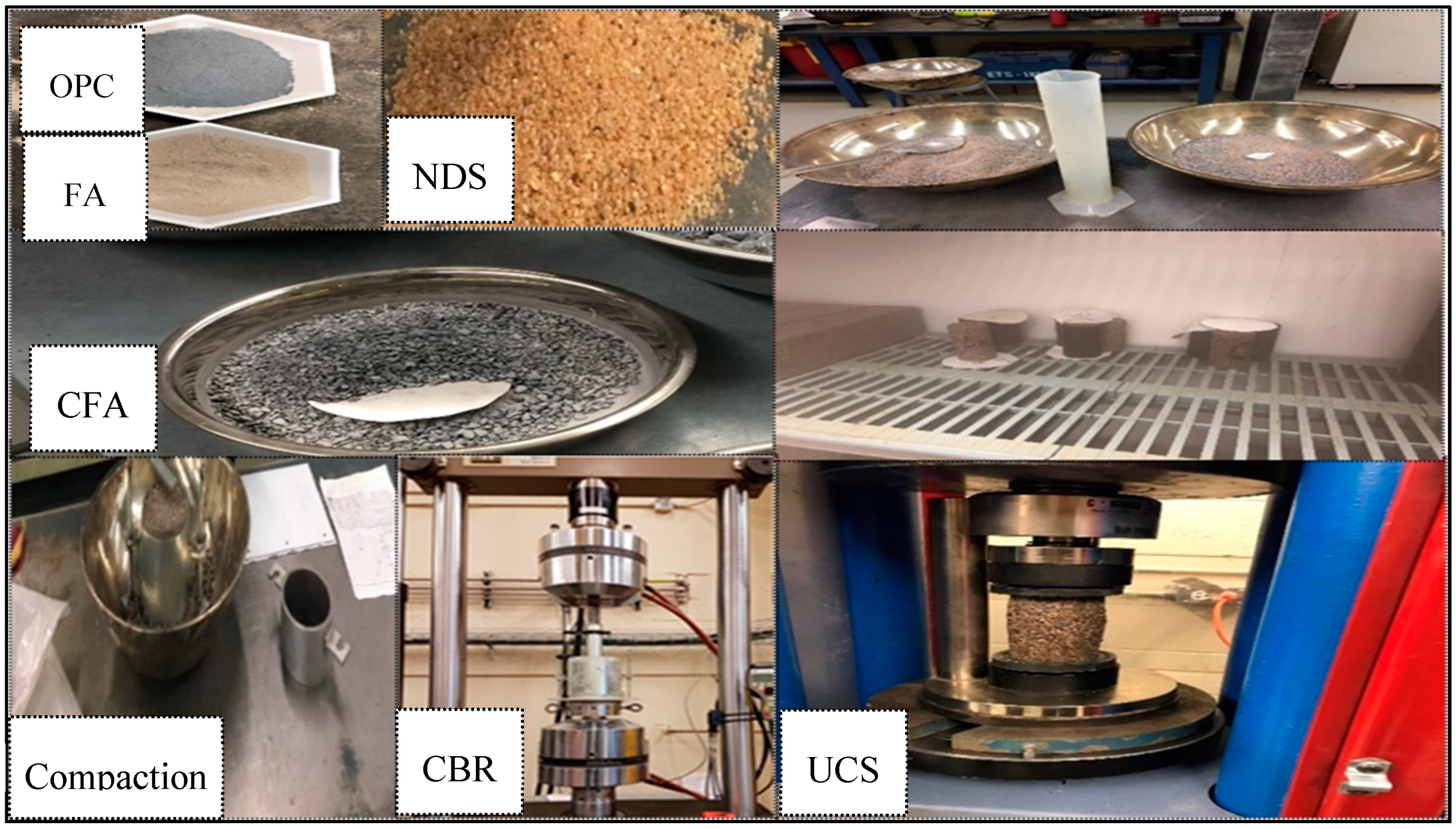

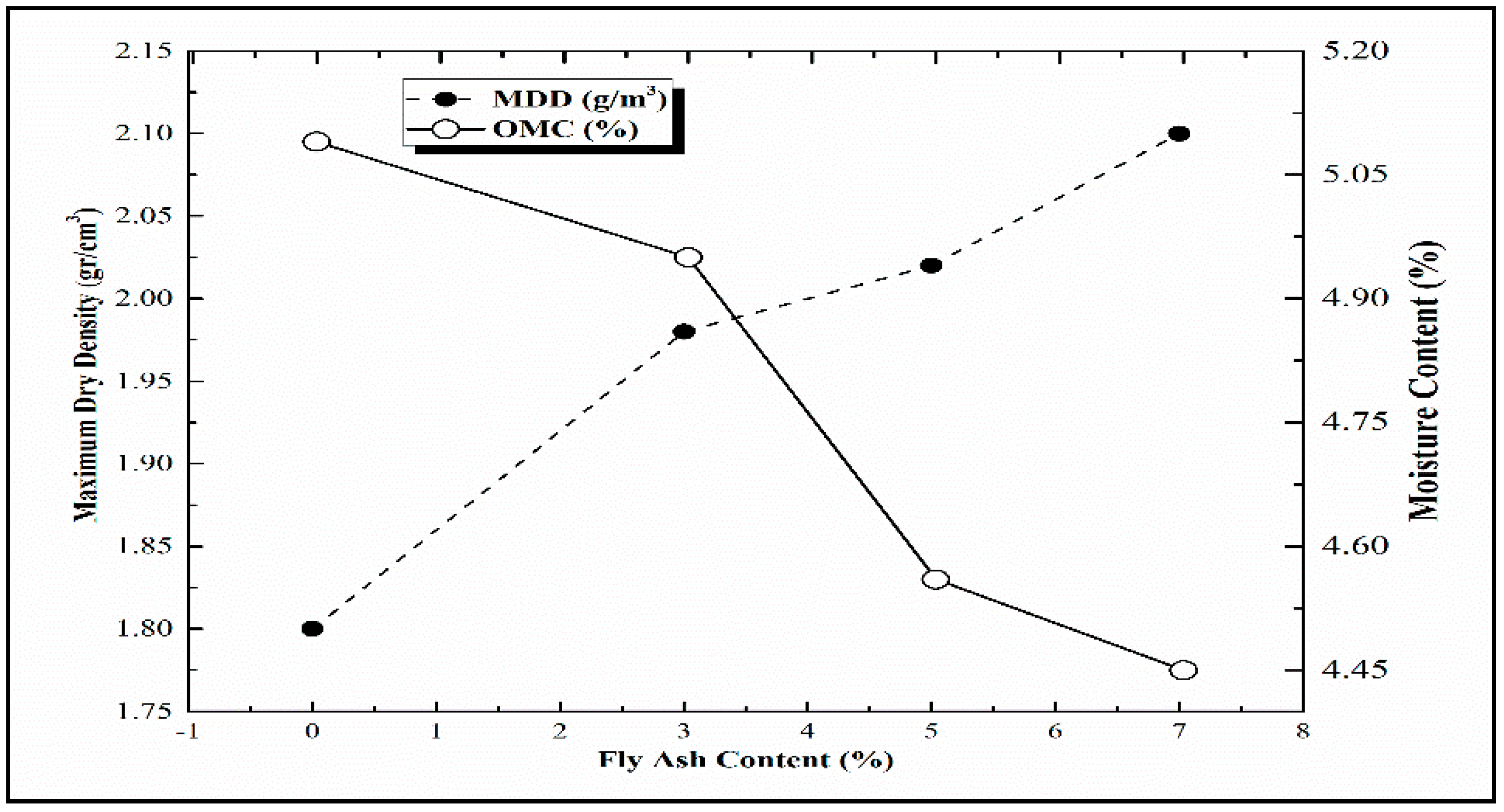

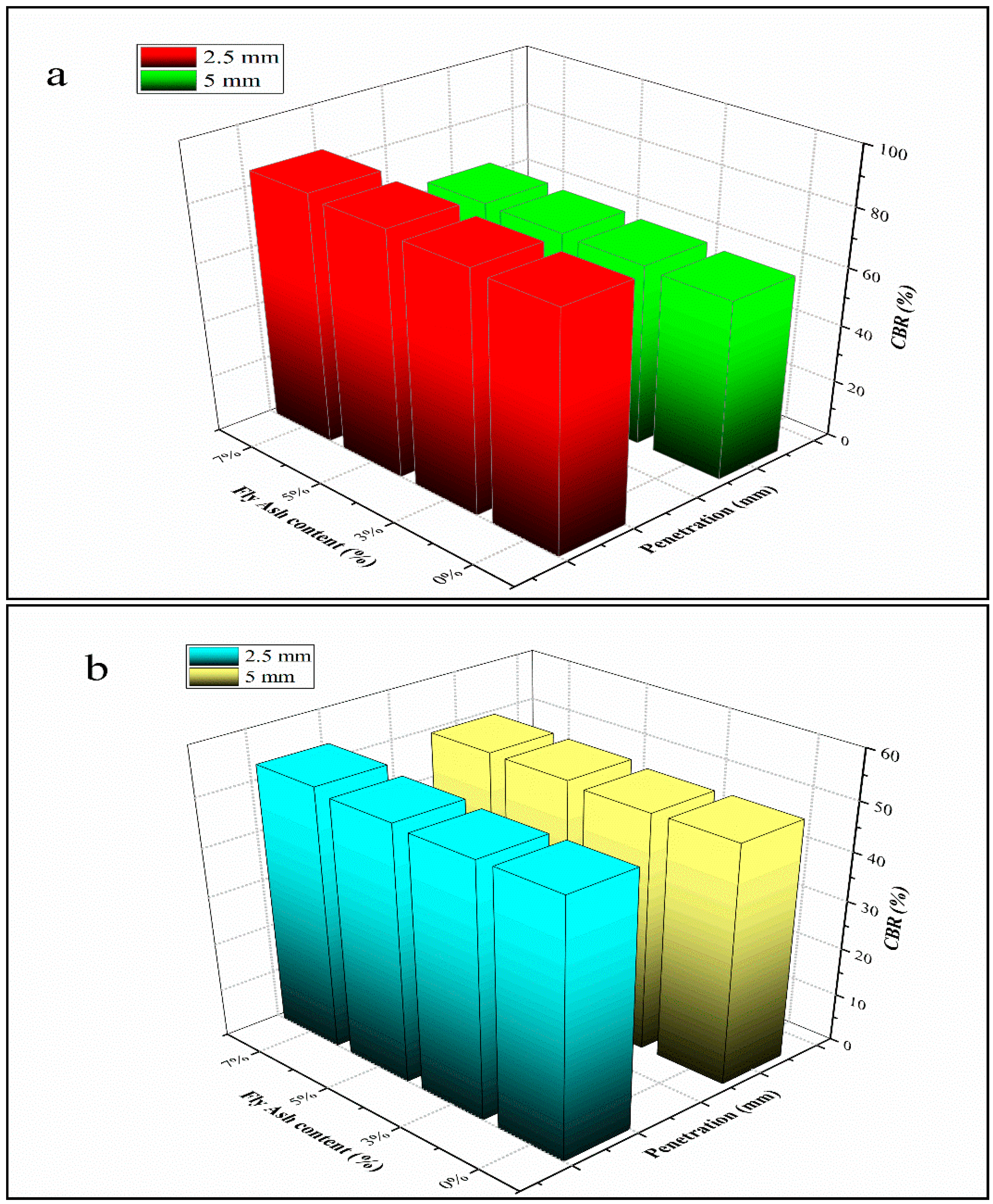


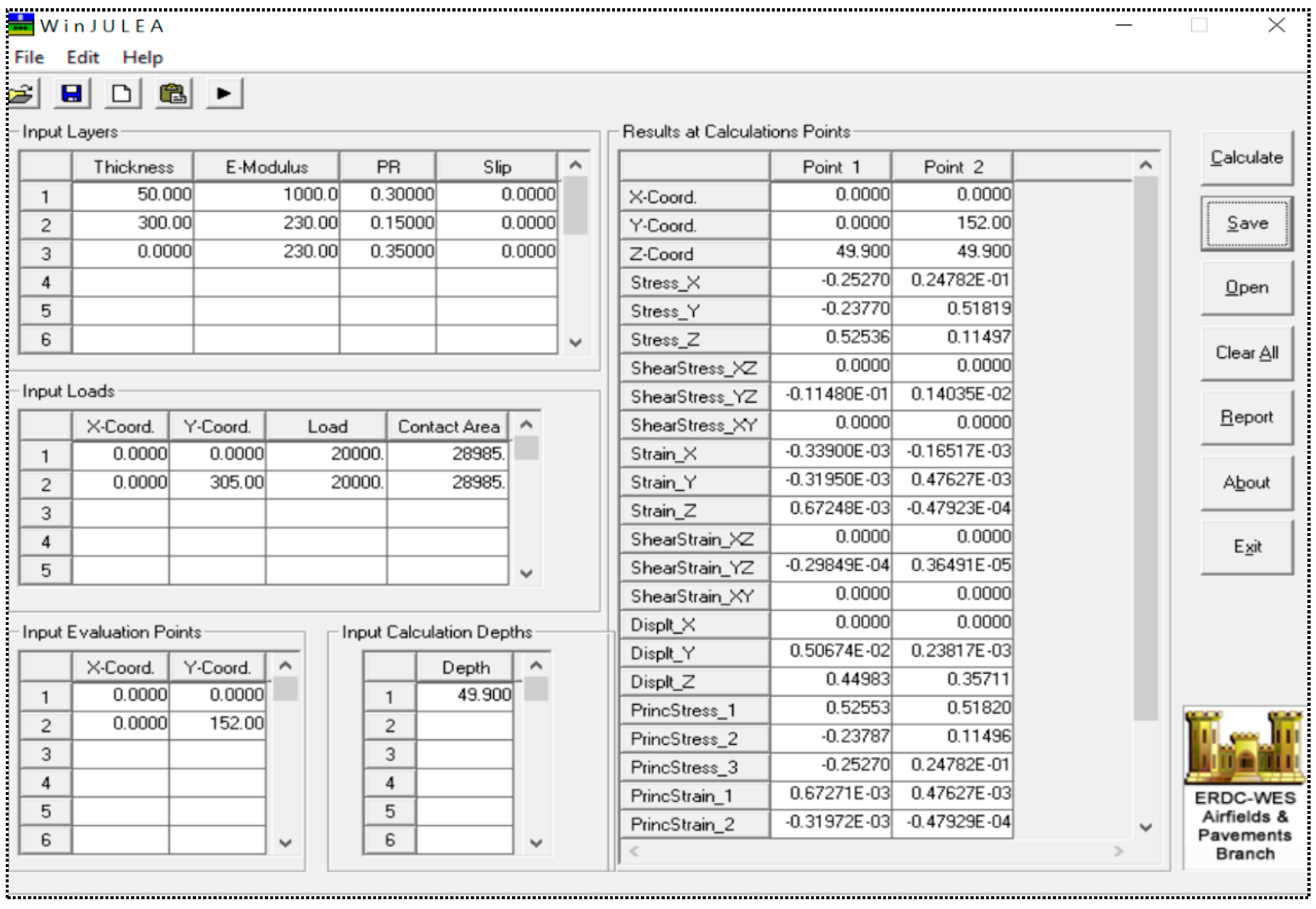

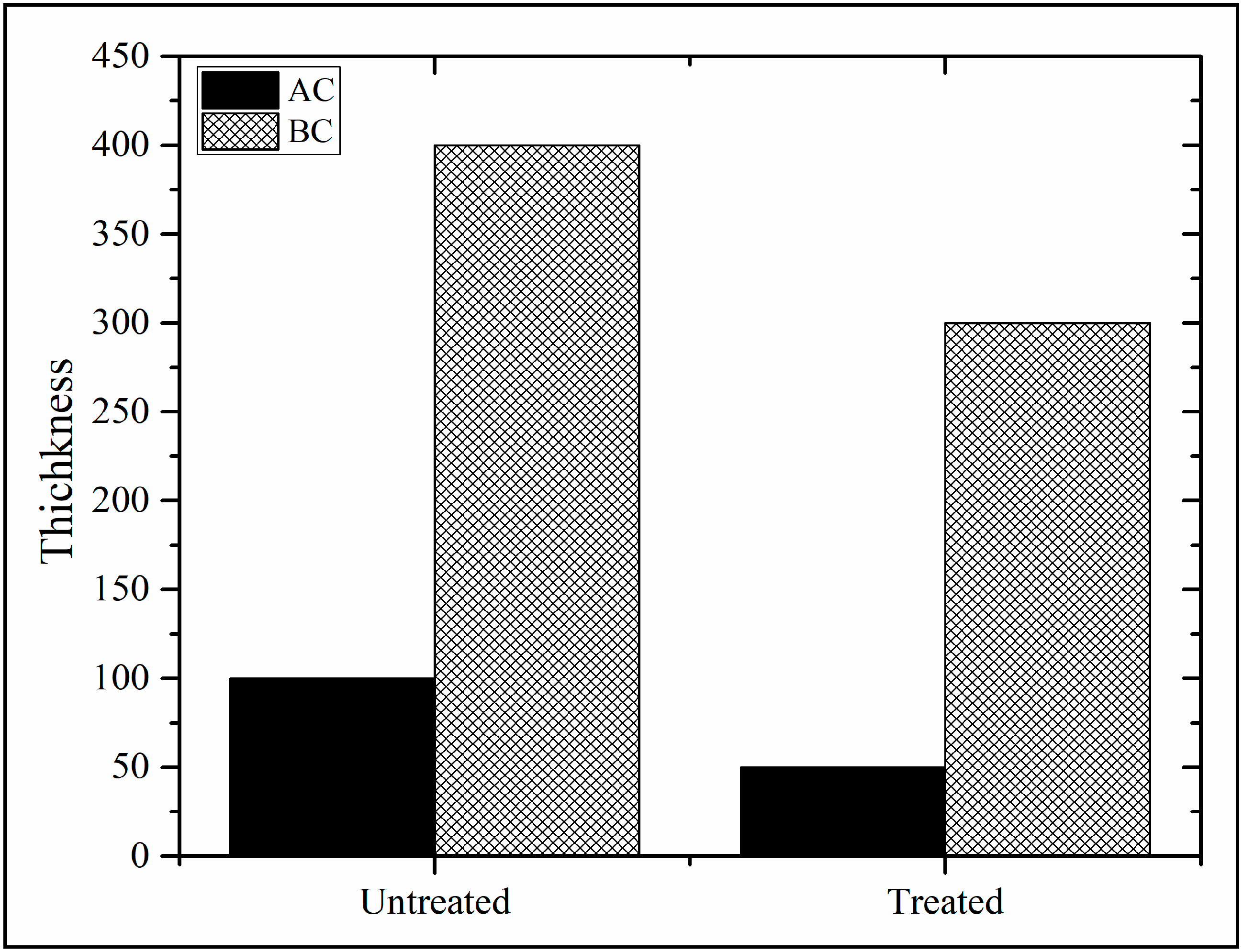
| Chemical Composition | NFS (%) | CFA (%) |
|---|---|---|
| Silica (SiO2) | 83.12 | 87.10 |
| Aluminum (Al2O3) | 11.51 | 8.04 |
| Iron (Fe2O3) | 2.53 | 1.31 |
| Potassium (K2O) | 0.34 | 0.12 |
| Titanium (TiO2) | 0.51 | 0.18 |
| Calcium (CaO) | 0.23 | 0.08 |
| Magnesium (MgO) | 0.11 | 2.16 |
| Sulfur (SO3) | 1.33 | 0.08 |
| Sodium (Na2O) | 0.12 | 0.93 |
| Barium (BaO) | 0.13 | - |
| Manganese (MnO) | 0.07 | - |
| Diameter (mm) | Mixture 30:70% | Mixture 50:50% |
|---|---|---|
| 28.00 | 100 | 100 |
| 20.00 | 100 | 100 |
| 14.00 | 100 | 100 |
| 10.00 | 98.4 | 98.4 |
| 5.00 | 41.8 | 59.7 |
| 2.50 | 24.7 | 43.6 |
| 1.25 | 7.2 | 7.6 |
| 0.63 | 5.3 | 4.5 |
| 0.32 | 2.8 | 1.9 |
| 0.16 | 1.6 | 1 |
| 0.080 | 0.2 | 0.2 |
| Compound | OPC | FA |
|---|---|---|
| % Composition | % Composition | |
| SiO2 | 18.20 | 62.04 |
| CaO | 59.03 | 9.10 |
| MgO | 1.80 | 1.03 |
| Al2O3 | 5.09 | 17.21 |
| Fe2O3 | 3.15 | 4.10 |
| Na2O | 0.18 | 0.03 |
| K2O | 0.29 | 1.21 |
| SO3 | 2.65 | 3.88 |
| Loss on Ignition (LOI) | 7.91 | 0.43 |
| Un-solvent materials | 1.02 | - |
| Penetration (mm) | CFA/NDS Ratio 30:70 with 5% OPC | CFA/NDS Ratio 50:50 with 5% OPC | ||||||
|---|---|---|---|---|---|---|---|---|
| 0 | 3 | 5 | 7 | 0 | 3 | 5 | 7 | |
| 2.5 mm CBR (%) | 82.20 | 83.20 | 84.80 | 86.30 | 52.17 | 52.1 | 52.75 | 53.81 |
| 5 mm CBR (%) | 62.40 | 63.40 | 64.10 | 64.70 | 49.32 | 49.11 | 49.87 | 50.04 |
Publisher’s Note: MDPI stays neutral with regard to jurisdictional claims in published maps and institutional affiliations. |
© 2021 by the authors. Licensee MDPI, Basel, Switzerland. This article is an open access article distributed under the terms and conditions of the Creative Commons Attribution (CC BY) license (https://creativecommons.org/licenses/by/4.0/).
Share and Cite
Amhadi, T.S.; Assaf, G.J. Improvement of Pavement Subgrade by Adding Cement and Fly Ash to Natural Desert Sand. Infrastructures 2021, 6, 151. https://doi.org/10.3390/infrastructures6110151
Amhadi TS, Assaf GJ. Improvement of Pavement Subgrade by Adding Cement and Fly Ash to Natural Desert Sand. Infrastructures. 2021; 6(11):151. https://doi.org/10.3390/infrastructures6110151
Chicago/Turabian StyleAmhadi, Talal S., and Gabriel J. Assaf. 2021. "Improvement of Pavement Subgrade by Adding Cement and Fly Ash to Natural Desert Sand" Infrastructures 6, no. 11: 151. https://doi.org/10.3390/infrastructures6110151
APA StyleAmhadi, T. S., & Assaf, G. J. (2021). Improvement of Pavement Subgrade by Adding Cement and Fly Ash to Natural Desert Sand. Infrastructures, 6(11), 151. https://doi.org/10.3390/infrastructures6110151






